Katie and I thru hiked the John Muir Trail/Nüümü Poyo in August 2020. Usually, my style is ultra minimalist in hopes of setting a speed record, like hiking the 272-mile Long Trail in less than 5 days or the 2,160-mile Appalachian Trail in less than 46 days. This time, my pace was a little different: Katie and I hiked together instead of her being my crew chief.
On this trip, jumping in alpine lakes and making new friends was just as important as logging miles. While our pace was considerably slower, I brought my ultralight methodology of fastpacking to couples thru-hiking and we managed to have a wonderfully successful and enjoyable adventure with minimal weight on our backs.
In this article I outline conditions we faced and the John Muir Trail gear list I used from start to finish which should give you a good point of reference should you desire to do the JMT yourself (and you should!).
Conditions
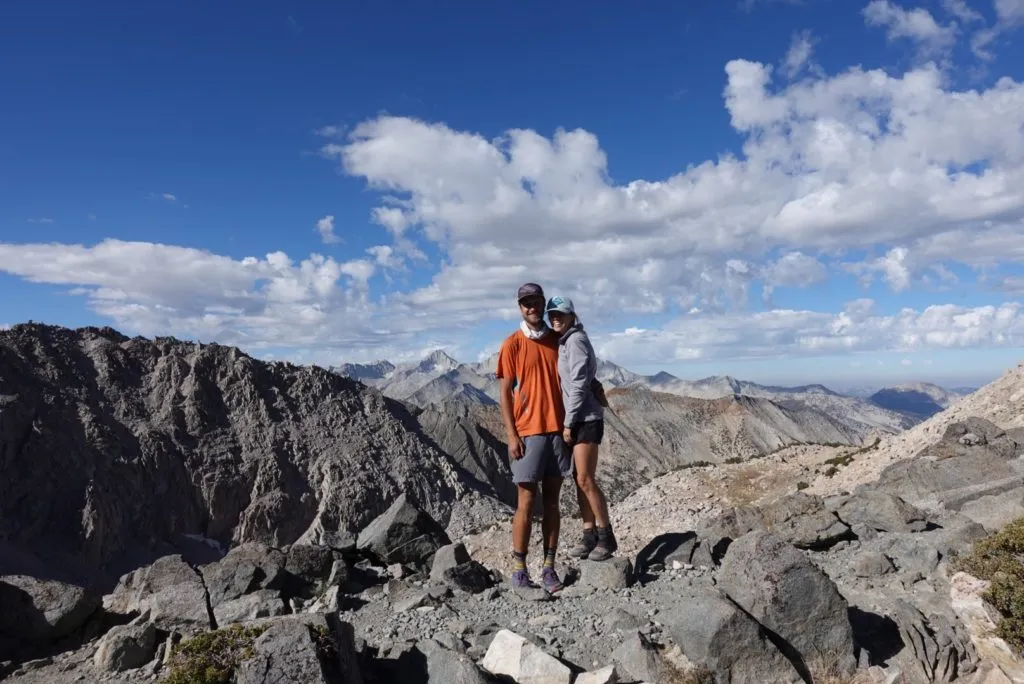
Working as a backpacking guide, the first mistake I notice for novice backpackers is that they “pack for their fears”. There are lots of ways to be a better backpacker, but I find this to be the biggest challenge to overcome for a novice. Often, we put in a few extra snack bars because we worry we will go hungry, or we pack a second fleece jacket because we heard it might get cold. Instead, hikers should be looking to thoroughly analyzing conditions before considering gear choices.
Since we were thru-hiking, Katie and I looked at historic temperature highs/lows/averages using NOAA. We consulted trip reports on the John Muir Thru Hiker 2020 page on Facebook to get insight on snow level and bugs. Through our research, we knew that we would be in heavily exposed areas (hello, sunshine) with expected temps between 30-80 (moderate), lots of water (glug, glug, glug) and no bugs (thank GOD). That’s about as good as it can get and makes packing rather simple.
Gear Introduction
An experienced backpacker is able to make a few smart decisions to significantly reduce the amount of pack-weight, which can lead to benefits such as a lower likelihood of injury, faster hiking paces, and less clutter. Katie and I benefited from having put in a lot of miles on trail and knowing what we can (and should) leave at home. The result was that my John Muir Trail gear list base weight was about 17 pounds–and never topped 30lbs even with food, water, and fuel –compared to 55 pounds, which was the pack weight of a hiker friend we made on trail (and anecdotally the average of what we saw).
For the sake of clarity, I have broken up my gear into 8 sections:
- Worn Clothing
- Sleep and Element Protection
- Backpack
- Shelter and Sleep
- Kitchen
- Hydration
- Electronics
- Personal
For each section I’ve written a short write up and reflections on individual pieces of from my John Muir Trail Gear List.
Worn Clothing

My worn clothing is pretty simple and I generally hike in a pair of lightweight shorts and a t-shirt. While many hikers will opt for long sleeves or hiking pants in exposed locations like the High Sierras, but because my skin doesn’t burn very easily I felt comfortable with less sun protection gear than most other hikers.
| Item | Name | Oz | Comments |
| Shirt | Columbia Titan Shirt | 3.2 | Fast drying, light, perfect shirt. Had considered long sleeves, but I tan well and applied sun tan lotion when necessary |
| Shorts | Columbia Titan Ultra Shorts | 7.3 | Comfy inner liner, no chafe. Lots of material/slow drying when jumping in lakes |
| Hat | Columbia Trucker Hat | 2.8 | Most people wear sun-protective hats, this would have made life a little easier as I wouldn’t have to worry about my neck burning. My face didn’t burn, and since I tuck my ears under my cap, neither did they! |
| Poles | Cascade Mountain Tech Poles | 17.6 | A little heavier than Black Diamond, but affordable, durable and adjustable for the MLD tent. I wish the bottom tread piece was smaller |
| Shoes | Columbia FKT | 25.6 | Great grip and kept sand and dirt out well. Shoes were very comfortable, no blisters and toes looked great after 16 days. Very happy with these shoes for hiking! |
| Socks | Injinji Hiker Midcalves | 2.6 | Wore every day, very durable. In the future, would use quarter length socks to minimize dust pickup |
| Watch | Coros Vertix | 2.7 | Great watch for backpacking. Ended with ~40% battery life without charging. Altimeter was useful to measure our elevation on mountain passes. |
Total Weight: 61.8 oz (note: worn weight does not count towards base weight)
Sleep and Element Protection Clothing

Given the nighttime temps and the relatively ‘cold’ sleeping bag I brought, I wanted extra clothing in case conditions went south. While sub-freezing temperatures and storms are to be expected this time of year, we really lucked out with the weather. I could have left one or two articles of clothing at home and been okay, however given the conditions of the Sierras, that wouldn’t have been a smart choice.
| Item | Name | Oz | Comments |
| Puffy | Columbia Altra Down Puffy | 13.6 | Performed perfectly with lows in high 30s. Used it to sleep at higher elevations and was never cold. |
| Long Sleeve | Columbia Omni-Heat LS | 8.3 | Should have ordered a L instead of an M, my armpits sometimes rubbed. Great piece of gear, very insulating. Used exclusively in camp. |
| Buff | Columbia PFG Buff | 1.2 | Great for COVID. doesn’t protect my whole neck from sun. |
| Hat | Seahawks Hat | 4.4 | GO ‘HAWKS! |
| Socks | Injinji Lightweight Crew | 1.2 | Sleeping socks, backup hiking socks. Nice to have, but not necessary |
| Rain Jacket | Columbia OutDry Ex | 6.6 | Only needed a handful of times. Love this jacket. |
| Pants | Columbia Trail Tech | 10.8 | Used in camp and sleep. Very comfortable and thick enough to prevent bugs. |
| Leggings | Columbia Running Tights | 5.8 | Used once while sleeping. Backup to pants above. |
Total Weight: 53.4 oz
Pack
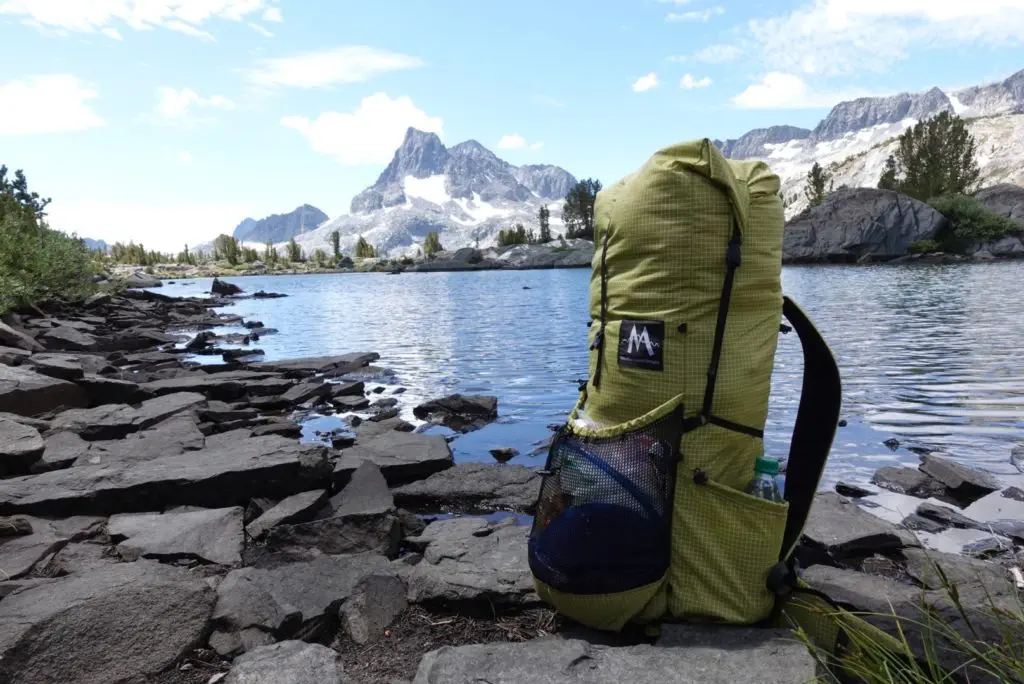
I love frameless backpacks, and I’ve used the MLD Exoudus 57L on multiple trips now and am very happy with its performance. My favorite configuration is using a Zlite SOL to provide some internal structure which helps increase the carrying load of ultralight packs. I was able to comfortably fit the BearVault into my bag, which is a big concern for many hikers. In my opinion, this is only an issue if your pack capacity is 45L and under, although Katie had the Gossamer Gear 4-20 (42L) pack and it worked.
| Type | Name | Oz | Comments |
| Backpack | Mountain Laurel Design Exodus 57L | 19 | Online stated to hold up to 25. I had 28 with a bear canister and felt good. Used Z pad as my internal frame. 57 L gave me a little extra carrying capacity which was nice since Katie and I shared gear. My right shoulder isn’t flexible enough to reach the side pocket, but my left one is. Enough exterior carrying capacity for snacks and water that I never had to go back into my bag during the day. BV500 fit best in the middle of my bag. |
| Back Canister | BV 500 | 42.8 | Carried all the food we needed! 7 days worth of food (23000 cal) was a little tight. No bear issues. |
| Frame | Thermarest ZLite Sol | 10 | #multiuse |
Total Weight: 71.8 oz
Shelter and Sleep
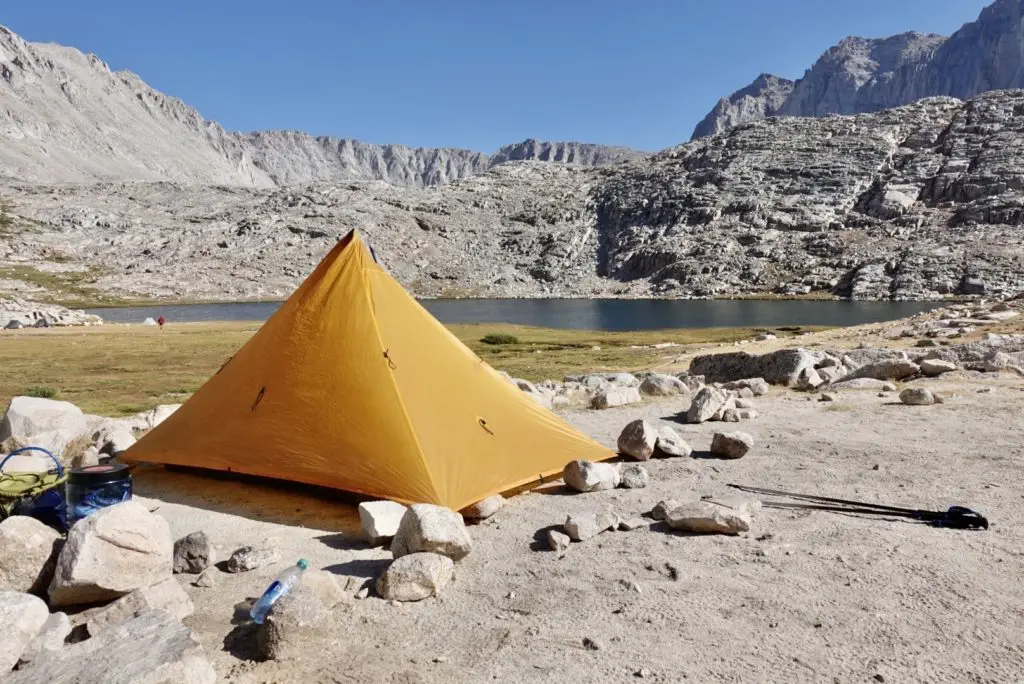
Katie and I both stayed in the same Mountain Laurel Designs shelter. I’m 6’4″ (which is where I got the name Stringbean) and was able to sleep comfortably in this tent – highly recommended as a lightweight option for all you tall people out there! I was also pleasantly surprised that my quilt was as comfortable as it was.
| Type | Name | Oz | Comments |
| Shelter | MLD Duomid XL | 17.6 | Comfortable, insulating, fairly straightforward to set up. Lasted very well through a few overnight storms with no issues. Used for Katie and me. |
| Inner | MLD Inner + Stakes | 18.3 | Used MLD stakes & guyline. Stakes will bend under high pressure. |
| Poles | CMT Trekking Poles | – | Used as poles for shelter. Adjustable height was essential. |
| Quilt | EE Revelation 40 Degree | 15.5 | Am I crazy for bringing a 40 degree quilt? Maybe 😏 has extra clothes for insulation when necessary, never was uncomfortably cold. Great bag for the majority of nights. |
| Pad | Thermarest Zlite Sol | – | The more I use the Zlite Sol, the more I worship it. Hassle free piece of gear that also pulled double duty as my pack frame and back padding. That being said, I do toss and turn on it. |
Total Weight: 51.4 oz
Kitchen
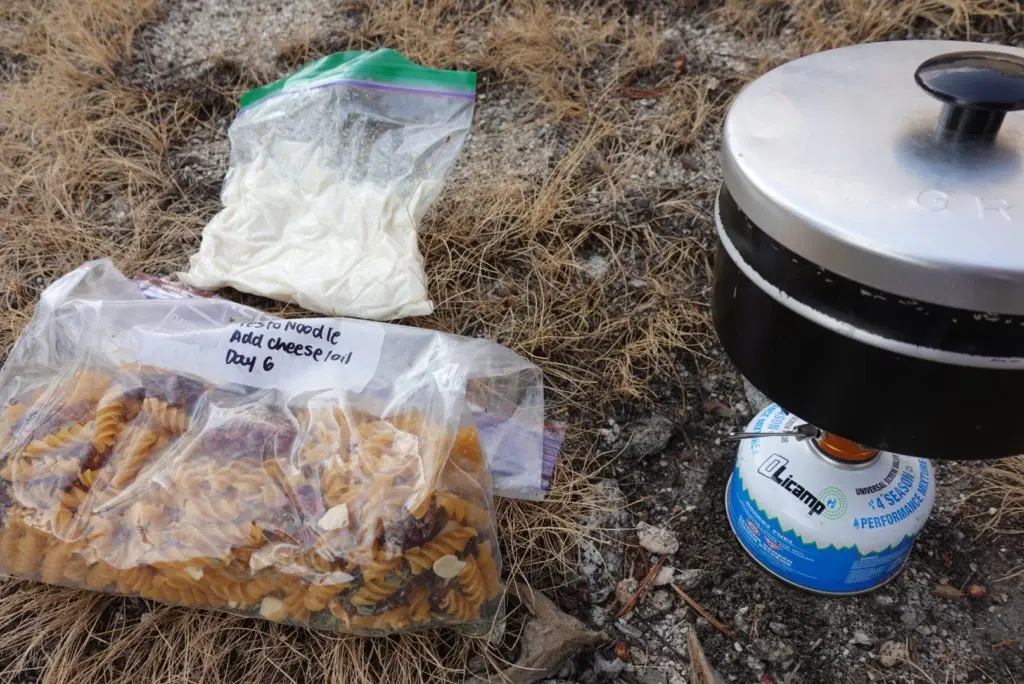
This was our biggest mistake: alcohol stoves are allowed in California, but the sale of alcohol stove fuel is not. So when we showed up at Red’s Meadow to buy more fuel 1/3 of the way into our trip, there was none. Luckily, we had been hiking with ‘Naughty Scotty’ from Tewksbury, MA, who happened to have an extra stove in his backpack that we could use. For the rest of the trip, we carried two stoves.
| Type | Name | Oz | Comments |
| Alcohol Stove | Caldera Sidewinder | 7.9 | Performed well, but didn’t realize we’d have an issue buying alcohol fuel! |
| Backup Stove | AOTU Stove | 3.9 | Was gifted a stove after we weren’t able to buy alcohol fuel at Red’s Meadow. This was a major hassle. |
| Alcohol Fuel | Denatured Alcohol Fuel | 7 | Alcohol stoves are not banned in CA, but the sale of the alcohol fuel is. That was a problem. |
| Canister Fuel | MSR 4oz | 5.5 | |
| Bowl | Plastic | 2.8 | Nice to have with 2 people |
| Mug | Metal | 3.2 | I <3 tea |
| Lighter | Bic | .7 | Can’t beat a Bic |
| Spork | Plastic | .6 |
Total Weight: 22.2 oz* not including canister stove + fuel
Hydration
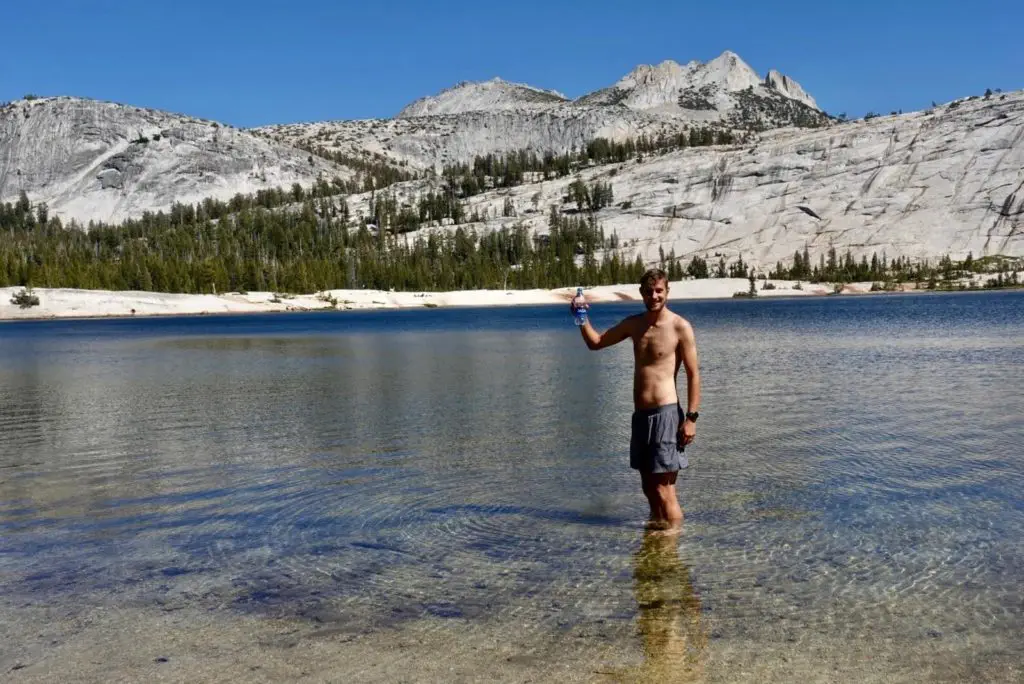
I love having front-of-pack access to water, which makes it simple and fast to hydrate. In a location like the Sierra, you often don’t notice how much you are sweating so by the time you realize you’re getting dehydrated, you’re already behind. Putting a Sawyer filter on my front pocket ensures that I have easy access to water and will drink regularly. Aquamira is another great option to consider if you are hiking only with a bladder.
| Type | Name | Oz | Comments |
| Bottle | Dasani 600ml (x2) | 2 | Used for easy front pocket access and so Sawyer can easily fit. Never needed more than 1L of water in August. |
| Bladder | Camelbak Hydration Bladder | 7.1 | Didn’t ever need the extra carrying capacity. Was nice as back up. |
| Filter | Sawyer Mini | 3 | Worked great for 16 days with regular backflushes. Drank straight from the filter. Water flow diminished over 16 days, but was stronger than other filters (Katadyn BeFree and Sawyer Micro Squeeze) after 2 weeks. |
| Filter | Sawyer Backflush | 1.1 | |
| Backup | Aquamira | 2.4 | Only used when treating water in bladder. |
Total Weight: 15.6 oz
Electronics
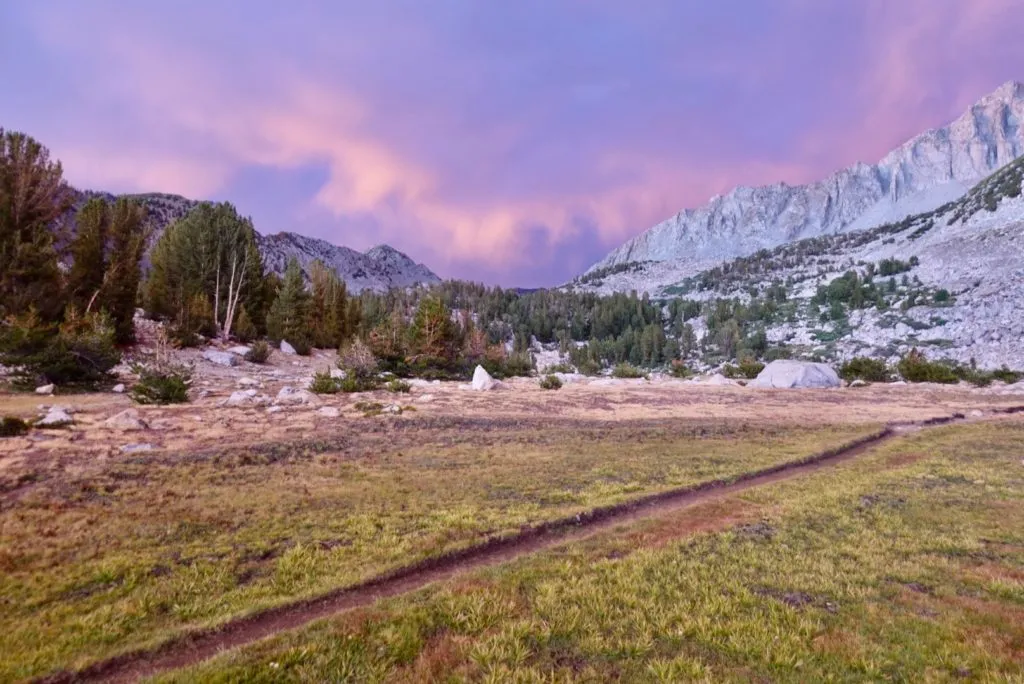
Electronics account for 15% of my John Muir Trail gear list base weight, isn’t that a crazy stat? Some of these items are luxury items. People have been backpacking for 40 years before things like iPhones, digital cameras, or satellite communicators existed. Nevertheless, I feel that these items add high value to my experience in being able to capture and navigate my surroundings.
| Type | Name | Oz | Comments |
| Headlamp | Petzl NAO | 6.7 | Love this headlamp! 700 lumen. Headlamp can accidentally turn on in pack if you don’t use the safety feature which drains battery (learned that the hard way on the Long Trail!). |
| Phone | iPhone XR | 8.5 | Takes great photo, battery life was significantly increased by 1) using low power mode 2) deleting all background data 3) using airplane mode. |
| Camera | Sony RX100V + Batteries | 12.9 | Amazing camera that took all the great photos in this blog! A few DSLR camera owners carrying up to 6 extra pounds were quite jealous of the size of my camera. |
| Sat Comm | Garmin inReach mini | 3.5 | Finally upgraded from the Spot – SO worth it. |
| Battery | Anker 10,000 mAh | 6.7 | 10,000 mAh was a good amount of battery for myself and my wife for 7 days with minimal cell phone usage. |
| Cords | Mini USB + iPhone | 1 |
Total Weight: 39.3 oz
Personal
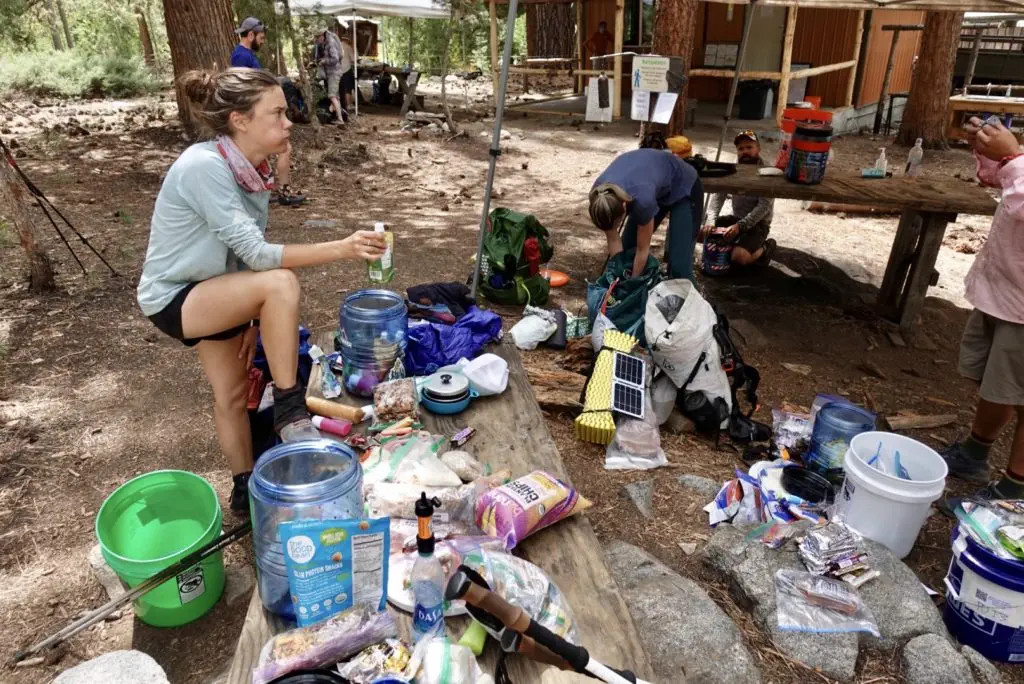
The nitty-gritties. Since most of these items are no-brainers, and you made it this far in my article, I will share a fun story regarding toilet paper. Once you hit Mt. Whitney, the final 16 miles of the John Muir Trail, you are required to pack out ‘all human waste.’ Yep, that includes poop. So, how does one go about doing that? Well, hikers we met on the trail had brought Wag bags with them, the kind you would use to pick up after your dog. Unfortunately, by that point all I had was an old Fritos bag. I’m sure you can imagine how that went.
| Type | Name | Oz | Comments |
| Mouth | Toothbrush | .2 | |
| Bathroom | TP | 1 | Always pack more than you think you need |
| Knife | Swiss Army Knife | 3.6 | One of the few must-haves from Boy Scouts that is still a must-have |
| Maps | Nat Geo JMT Maps | 3.2 | Bring paper maps! It’ll make the trip more fun. Plus, you don’t have to drain your phone battery relying on GPS |
| First Aid | Home made | 4.8 | Andrew Skurka has a great checklist |
| Pills & Meds | Home made | 5.1 | Pro tip: Be careful with Diamox. Katie and I had significant symptoms including tingling and vomiting and stopped taking after day 2. |
| Bug Spray | Sawyer Picardin | 4 | In mid August of a dry year, there are no bugs. Should have left this at home! |
TotalWeight: 21.9 oz
Takeaways
Hopefully my John Muir Trail gear list provides some insight and inspiration for anyone who is planning a JMT thru-hike. It’s very easy to go overboard with gear and “pack your fears”, but with some experience and research you’ll find that you likely don’t need as much as you thought. That being said, you should always check the conditions of where you’ll be hiking as those will be the largest factor in determining what you bring.
Also, gear can be notoriously expensive and niche – don’t feel pressured to have the latest and lightest of every item. Check sites like LWHiker.com to find used gear or wait for sales and upgrade items as your budget allows. Soon enough, you will have a lightweight and comfortable kit that is adaptable for nearly any trail.
Feel free to ask for gear recommendations or insights in the comments below!
This post contains affiliate links. I earn a small commission on sales via these links at no additional cost to you. If you'd like to support me, please purchase products through the affiliate links. Thanks!




So what would you change?
Could you post Katie’s list? Would be super helpful.
Here is a link to our JMT Google doc. Katie’s list is on there plus a lot of our food planning and information! https://docs.google.com/spreadsheets/d/15tv9_P6FN8o2v-swWLN-NCHCctrGcuFvM2MB5j6PVKU/edit?usp=sharing